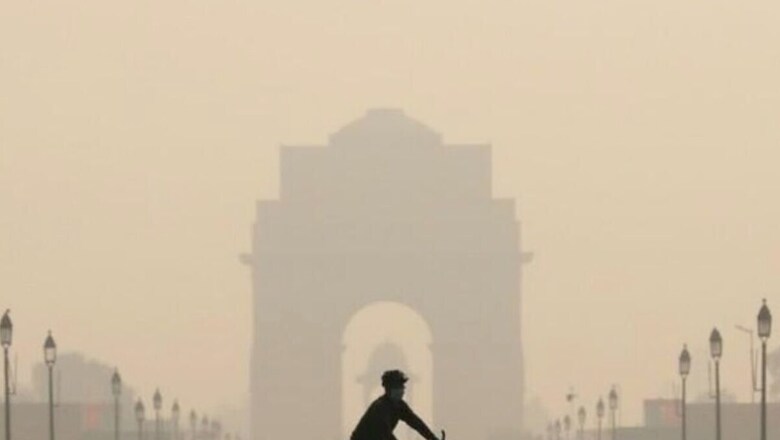
views
The government’s ambitious National Clean Air Programme (NCAP) must not get reduced to being just a dust-control plan, but focus on controlling more harmful PM2.5 emissions from industries, vehicles as well as biomass burning, New Delhi-based Centre for Science & Environment (CSE) said in a new assessment.
According to the experts, over 64 per cent of funds under the NCAP and 15th Finance Commission have just been spent on road dust mitigation. Much less has gone towards controlling emissions from combustion sources — with industrial pollution getting 0.61 per cent, vehicular pollution 12.63 per cent, and biomass burning 14.51 per cent.
“While NCAP’s objectives and aims have always been commendable, we are finding that attention and investments under it are largely focused on dust control, and not on emission-spewing combustion sources such as industries or vehicles,” remarked CSE Director-General Sunita Narain on Friday.
The ambitious programme was launched in January 2019 to improve air quality in 131 polluted cities (non-attainment cities and million plus cities). Nearly Rs 10,566 crore has been released for the 131 cities so far under NCAP, of which Rs 6,806.15 crore (64 per cent) has been utilised till May 3.
FOCUS ON DEADLY PM2.5 — TRANSPORT & INDUSTRIAL EMISSIONS
Under NCAP, the government had set clean air targets for the cities – up to 40% reduction or achievement of National Ambient Air Quality Standards for Particulate Matter concentrations by 2025-26 from the base year of 2019-20. However, experts pointed out that taking PM10 as the basis for assessing air quality improvement has diverted attention and investments towards merely dust control, while major toxic sources of pollution were neglected.
The CSE has recommended in its report that the NCAP should now shift the benchmark for assessing performance of cities from PM10 to PM2.5, which is way more harmful as it can go deep into the lungs and cause respiratory problems. PM2.5, emitted largely from combustion sources, is also a more relevant health indicator to assess improvement in air quality, while PM10 is highly influenced by meteorological conditions, rather than just policy actions.
MISMATCH WITH ACTION ON GROUND, REVISE METRICS
The CSE report flagged serious concerns with the way the programme has been run through the five years of its operation. The experts also found no clear correlation between policy implementation and PM10 improvement. For instance, cities like Agra, Delhi, Ghaziabad, Meerut and Jabalpur (>10 lakh population category) performed well under the Swachh Vayu Sarvekshan (SVS), but performed poorly under the NCAP for reducing PM10. National capital Delhi ranked 9th under SVS for implementing policy measures, but is at the bottom, scoring zero, under the NCAP. There is no way to establish the link between action and improvement in PM10 levels, it said in its report.
The CSE has also recommended that the method of tracking progress and compliance should be made more transparent, and stronger. Also, while the NCAP cities need to demonstrate improvement in PM10 levels to access the funds, under the parallel programme of SVS, these cities are ranked based on policy measures implemented in managing sectors such as biomass, municipal solid waste, road dust, public awareness, besides improvement in PM10 concentrations.
“Cities are judged based on different metrics. There are serious questions about these metrics being used to benchmark progress and its implications for real improvement,” said Anumita Roychowdhury, Executive Director, CSE. “The new agenda for clearing the air has to gear up for scale and speed of change for transformative reform. This needs massive energy transition in all sectors.”
KEY POLLUTION SOURCES NEGLECTED, NEED FOR MORE TRANSPARENCY
According to the CSE, the NCAP, in its current form, has neglected action against key combustion sources – mainly industry, transport and solid fuels. The metrics need to be revised to bring focus on them. Industrial pollution control remains business-as-usual.
“Only if a non-attainment city is an industrial township, do some additional steps on industrial pollution control get reported. There is minimal reporting on stack emissions inspection, challans and closure notices or notification of approved fuel list. There is very little information in the city progress reports on upscaled action to accelerate clean fuels and technology transition,” as per the report.
Also, the annual ranking and improvement in air quality is not publicly available city-wise as part of the formal reporting system of NCAP. “It is not possible to determine the level, scale and quality of action in each sector or understand how top-performing cities achieved 80-100 per cent of their targets,” the report noted.

















Comments
0 comment